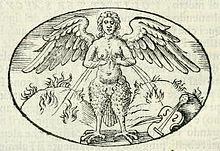Grouping Mythological Mythology Greek Region Sirenum scopuli | Sub grouping Siren Country Greece | |
 | ||
Parents Achelous and Terpsichore | ||
Parthenope (Greek: Παρθενόπη) was one of the Sirens in Greek mythology. Her name means "Maiden-voiced".
Contents
Myth
According to Greek legend, Parthenope was the daughter of the god Achelous and the Muse Terpsichore. She cast herself into the sea and drowned when her songs failed to entice Odysseus. Her body washed ashore at Naples, on the island of Megaride, where the Castel dell'Ovo is now located. When people from the city of Cumae settled there, they named their city Parthenope in her honor.
Roman myth tells a different version of the tale, in which a centaur called Vesuvius was enamored with Parthenope. In jealousy, Zeus turned the centaur into a volcano and Parthenope into the city of Naples. Thwarted in his desire, Vesuvius's anger is manifested in the mountain's frequent eruptions.
In literature and art
Parthenope has been depicted in various forms of literature and art, from ancient coins that bore her semblance to the Fountain of the Spinacorona, where she is depicted quenching the fires of Vesuvius with water from her breasts. In his Georgics, Virgil stated that he had been nurtured by Parthenope, writing:
At that time sweet Parthenope was nurturing me, Virgil, as I flourished in the pursuits of my inglorious leisure...
In addition, Parthenope has served as the inspiration for a number of other works, such as Manuel de Zumaya's Partenope and the ancient Greek novel Mētiokhos kai Parthenopē. Also, several operas based on the myth of Parthenope were composed on the 18th century by Sarro (1722), Vinci (1725), Handel (1730), Vivaldi (1738) and Hasse (1767).
